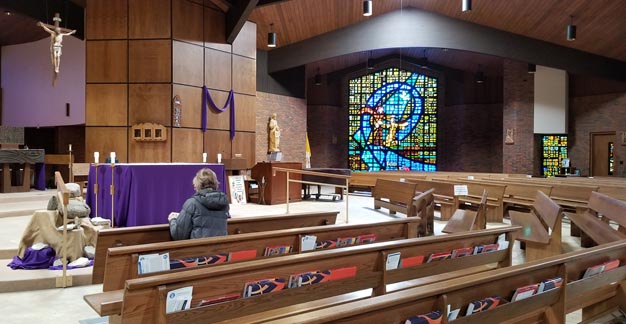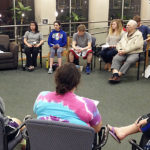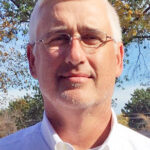
A woman prays inside Our Lady of Victory Church in Davenport in this file photo. Churches began opening for private prayers this week in the Diocese of Davenport. This is the first step in the reopening process.
By Barb Arland-Fye
The Catholic Messenger
Bishop Thomas Zinkula and his “COVID team” examined details to the nth degree in preparing a three-step plan, implemented this week, for the gradual return to public celebration of the Mass in the Diocese of Davenport. The plan maintains a commitment to the well-being and safety of clergy and lay people, the bishop told The Catholic Messenger.
“The desire of the faithful for Communion — with Christ in the Eucharist and with each other in person — is sacred and holy,” the bishop said. “Hopefully, we can return relatively soon to the public celebration of the Mass and their longing will be fulfilled. Until then, we will continue to stay close to the Lord and one another by means of personal prayer.”
The reopening of churches this week for private prayer moves the diocese toward “reasonable, responsible and gradual” resumption of the celebration of public Masses, the bishop said. “It will occur in three steps. Unfortunately, we likely will have to maintain physical distancing for quite some time. Throughout this process, all Catholics in the Diocese of Davenport are dispensed from the obligation to attend Sunday Mass.”
Deciding steps
Some dioceses, such as the Archdiocese of New York, are implementing a five-step plan. The Davenport Diocese chose a different approach. “The first draft of the policy written by the COVID team actually had an additional step, but after running it by the pastors and getting their input, we eliminated one of the steps,” Bishop Zinkula said May 23, prior to the plan’s implementation. “In terms of the number of steps, part of the issue is how one counts the steps. Do you count where you are at now — closed churches and no public Masses — as a step? Do you count being back to the normal celebration of the Mass as a step? So the number of steps is somewhat subjective.”
Bishop Zinkula consulted with his priests as a group via video conferencing on two separate occasions. He meets daily with the COVID team and consults with others as well. In his meeting with priests last week, “Everyone of course wants to begin celebrating public Masses again. A few of them were a little hesitant about reopening the churches as quickly as next week (the week of May 25). They didn’t think they were prepared to do that early in the week; they wanted to wait until later in the week. We talked a lot about specific issues related to celebrating the Mass and other sacraments under these circumstances.”
Asked about the input he received from priests regarding parishioners’ desire or fear to return to public Masses, Bishop Zinkula said, “It’s a mixed bag. Some are very anxious to return to the public celebration of the Mass and some are fearful. I totally understand such fears. That is why the dispensation from the obligation to attend Sunday Mass will remain in effect indefinitely, and I gave vulnerable priests the option of not celebrating public Masses if they aren’t ready to do so.”
Step one
The plan’s first step reopens the churches for private prayer if parishes maintain a process of regular cleaning and disinfection. The opening date is at the pastor’s discretion. Everyone must wear face protection and use hand sanitizer, and should bring their own. Parishes will have a limited number of masks and hand sanitizer available.
No more than 10 people may be in the church at any one time during step one. Public Masses will not be celebrated. Baptisms, weddings and funerals will be celebrated outside of Mass. Each gathering may include up to 10 people. Adoration chapels will remain closed.
Regarding eucharistic adoration, the bishop said, “The longer a group of people are together in a closed environment, especially over 30 minutes, the more risky it is. Deacon Frank Agnoli, diocesan director of liturgy and a member of the COVID team, said, “With visits you come in … pray … leave. Not everyone is there at the same time.”
Step two
The COVID team will continue to monitor data from the Iowa Department of Public Health to help determine when to move to step two of the diocesan plan. If the data show a downward trend for 14 days, celebration of public Masses will resume, with some restrictions. Public worship may take place at the discretion of the pastor if the parish maintains physical distancing, cleaning and disinfecting. Everyone must continue to wear face protection. Individuals at greater risk of infection due to age and/or health condition should stay home.
Households are to maintain six-foot distancing by sitting in every third pew and horizontally apart from other households. People will maintain proper distancing while gathering for Mass, during the Communion procession and when leaving. Singing should be omitted. Other church spaces may be used in addition to or instead of the church, with physical distancing maintained. Outdoor spaces on church property may be used as overflow or with Mass celebrated entirely outside. Audio should be provided, according to the plan’s second step.
In addition, public celebration of exposition and adoration may take place, with a 30-minute limit, if participants observe physical distancing requirements and wear face protection. Extraordinary ministers of Holy Communion will not visit homes. Pastors will receive the faculty to administer confirmation.
See comments from priests about opening churches, preparing for a return to Mass
Step three
The plan’s third step relaxes some of the liturgical restrictions and will take place when data support the conclusion that the diocese is between pandemic waves (reduction to low and constant or decreasing numbers for at least 14 days). At this time, seating in every other row can occur. A six-foot distance should be maintained between households horizontally. The Mass may include cantors, but without choir or hymns. The Gloria, psalm and responses may be sung. Baptisms, weddings and funerals may be celebrated at Mass.
Extraordinary ministers of Holy Communion who are not at high risk of infection may make home visits to the sick (not COVID-19 patients) if necessary. Communal celebration of the Anointing of the Sick is discouraged.
Once “herd immunity” is established, probably through the wide availability of a safe and effective vaccine, “normal” liturgical practices will resume, initially with the kind of precautions taken during the flu season.
If cases of coronavirus and deaths from COVID-19 spike again, Bishop Zinkula said, “We will have to reverse course and tighten things up again. Hopefully that won’t happen. Hopefully everyone will do what they need to do to keep it from happening.”











